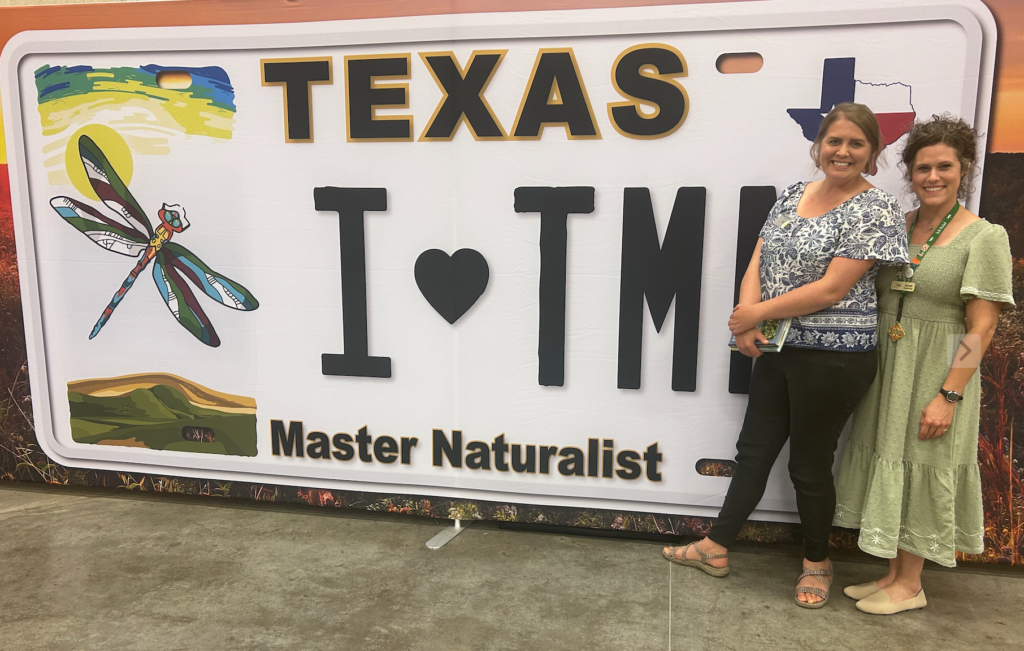Below are contributions from several of our chapter members about their experience at the Texas Master Naturalist Annual Meeting held in McAllen October 12 – 15, 2023.

To A State Meeting….At Last
By: Marsha Stephens
In 2016 I first became involved with helping form our chapter, and a few folks went off to the state meeting and returned with wonderful photos and stories to tell. Ditto 2017, 2018, 2019, 2020 (no, wait, it was only virtual), 2021, and 2022. As the years went by, I came to know that the event was something very special, changing and improving each year, and a must-do for every TMN to experience. Folks came back with new knowledge and new ideas and new vigor for our cause. Many came back with those precious bonds that form between chapter members through shared adventures. Many made their own contributions to the meeting via presentations, panel discussions, entries in various competitions and generally representing our chapter through participation. And each year I just pined to be a part of all of that, and thought “maybe in my next life”. All of this is to say, attending the 2023 state TMN meeting was a long-awaited experience for me.
Favorites? Where to begin…..or end? With an authoritative overview of existing scientific data and limitations thereof, Dr. Tania Homayoun of Texas Parks and Wildlife provided a thorough coverage of the challenges of evaluating, monitoring and managing bird population impacts from wind turbine farms and solar array facilities (“What Does Green and Clean Mean for Birds?”). The presentation pulled together thousands of pages of studies, reports, regulations and industry design information. The result was a fact-based understanding of what we know, what we don’t know, and what is on the horizon. One of the conclusions may surprise you: it is possible that the most benign twist on green energy from the standpoint of birds may be adoption of solar arrays by private homeowners and commercial building owners, especially if those arrays can be erected on existing parking lots……think covered parking for all!
The options for field site visits available for the meeting were so rich and diverse that choosing was a chore. Beyond the trip to El Sauz Ranch (more about that below), I was blown away by the Hugh Ramsey Nature Park in Harlingen, which is managed and supported largely through the efforts of Rio Grande Valley TMN chapter members. The site is a former dump that was covered with a soil cap (so there are occasional surprises that rise from the depths, and the substrate presents a variety of challenges, like broken glass). I immediately began thinking that maybe the choice of site for our Bosque River Nature Center isn’t so bad after all! With a vision of capturing the vast vegetative diversity of the region, the park has cultured extant and volunteer native species, and successfully added plantings of many others. Most memorable to me: a large specimen limoncillo tree (Esenbeckia runyonii), a native citrus that is considered by some to be the rarest tree species in Texas and perhaps in the United States (Tropical Limoncillo| March 2022 | TPW magazine). From the knowledgeable and dedicated TMN volunteers leading the visit, I gleaned two great ideas: (1) a slick little personal PA system for use when talking to a group in the field, and (2) having an assistant along who shows participants photos of the various species’ flowers and fruits from a regional floral guide book.
El Sauz Ranch, a part of the vast holdings of the East Foundation, was the ultimate destination adventure. The East in question was an early Texas rancher who had the good fortune to marry Alice Kleberg, the granddaughter of Richard King (founder of the King Ranch). The El Sauz unit was the site, and many East Foundation representatives were our hosts for the capstone experience of the meeting. How can you top a solar eclipse combined with the location for the film “The American Ocelot”? Welcome to Tamaulipan thorn forest and the Wild Horse Desert of South Texas, home to the largest remaining population of ocelots in the US. Eight chartered buses of Texas Master Naturalists were turned loose on the land for a few hours, “ocelot adjacent”. We couldn’t see them but we knew they were there.
Unforgettable. Magical. Worth the wait.

Night Blooming Cereus (with fruit; at Hugh Ramsey Nature Park)
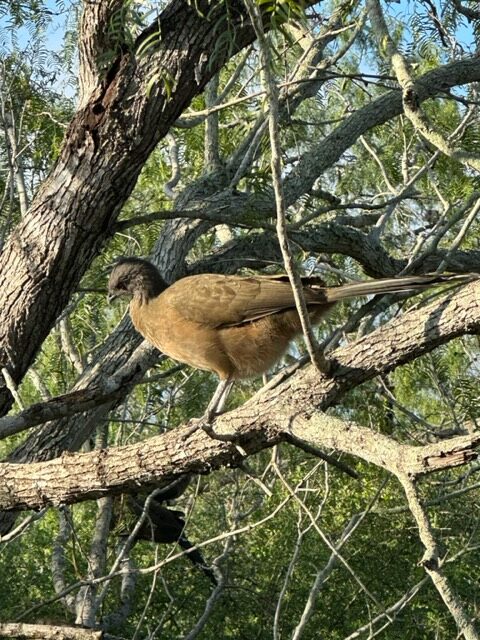
Chachalaca (think of them as “chickens of the trees”; at Hugh Ramsey Nature Park)

Texas Tortoise (when confronted with Texas Master Naturalists, pull in your head and hope for the best; at Palo Alto Battlefield National Historical Park)
TMN Annual Meeting
By: Kathy Weston
October 2023
McAllen, TX Convention Center
Each year I am amazed at the efficiency with lodging, food, technology, and at the amount of interesting information presented at the TMN annual meeting.
First, I was impressed by the community itself as they celebrated the century-old Latin American tradition of Día De Los Muertos (The Day of the Dead). The actual celebration is Nov 1 and 2, but evidence of the tradition was displayed inside and outside the convention center for all visitors to enjoy. The people I met in McAllen are proud of their city; many were born, raised, and work there… and have never left.
A second highlight was visiting the Pharr Memorial Library which had exhibits that took you a step back into the history of the area, and with a presentation by library staff on “The Library Explorer Adventure Pack Program (LEAP)”. This Rio Grande Valley (RGV) library was part of a pilot program that worked along Texas Children in Nature Network with a goal to connect children and families with outdoors and nature while creating a healthy, happy, and active outdoor lifestyle. Pharr was one of eight libraries across Hidalgo and Cameron Counties participating in the program. The LEAP backpacks are checked out from local libraries for a 2-week period using a library card and are fully stocked with supplies needed for self-directed exploration in the outdoors. Ten themes are currently available for checkout. Some current themes include Fishing, Birding, Night Sky, Tracks, Coastal Wildlife, Rocks and Fossils, Insects and Native Plants & Botany. Examples of backpack supplies include nature books, ID guides, journals, binoculars, compass, colored pencils, and free passes to Texas State Parks in the area. Activities for parents are included in the backpack to encourage whole family support. This unique program that connects children to nature is expected to grow throughout the state. WOW… A happy child is a healthy child!
Loading about 500 people on buses and traveling to a large working ranch in the area to see the annular eclipse and enjoy the area for the day was also a highlight.
Overall, the annual meeting was a huge success with learning, awards, shopping, and spending time with Prairie Oaks Chapter members.


Photographing the Eclipse
By: Lynn Wood
The high point for me was being able to photograph the eclipse. I was probably the only photographer that tried to photograph the entire eclipse (despite the clouds).
For more information about Lynn’s process, visit his article Photographing a Solar Eclipse.
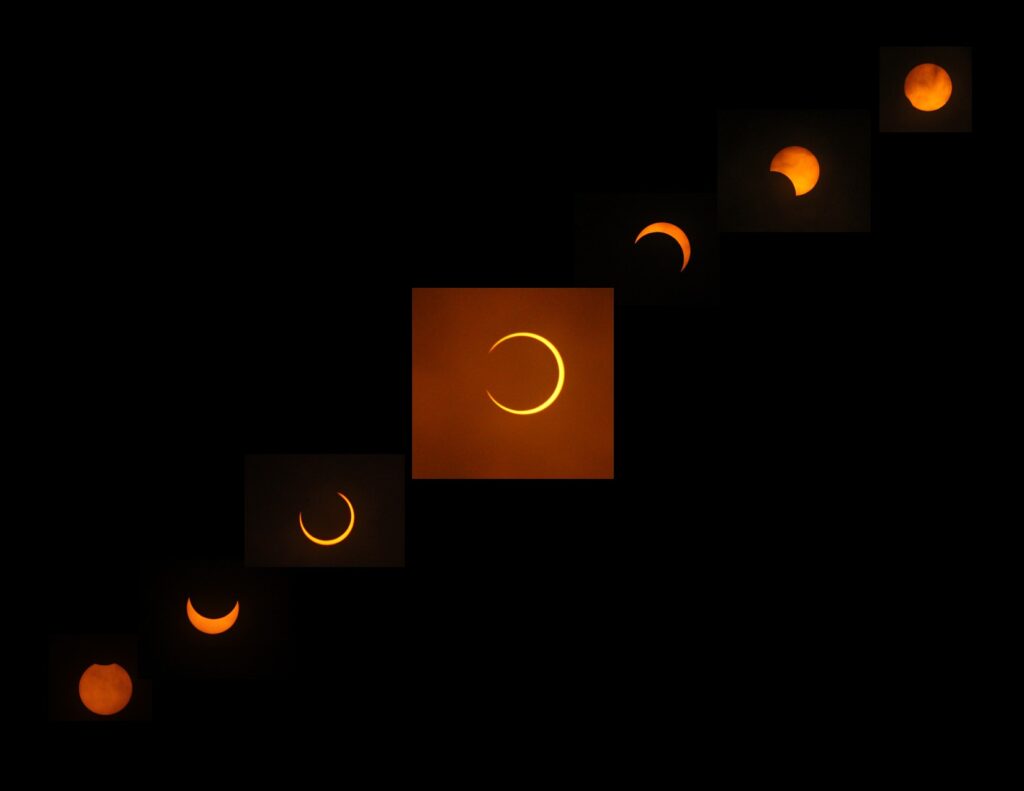
Local Birdlife
By: Katie Moses
This year’s annual meeting was definitely worth the 7 hour drive that it took to get there! It was my first time to go to “the valley”, which we learned is not actually a valley but a delta. The AT sessions during the week and the field day at El Sauz ranch were amazing but the highlight of my trip was getting to see the local birdlife that we don’t have in our part of the state. Upon arriving to the region, my travel buddies and I went to Bentsen-Rio Grande Valley State Park where we met the Plains Chachalacas and had our first sighting of the beautiful Green Jay. Our field trips to the Edinburg Scenic Wetlands and Estero Llano Grande State Park allowed us to see a plethora of waterfowl as well as many more sightings of the chachalacas. Getting to explore another ecoregion was fun and it was such a joy to gather with Master Naturalists from all around the state to celebrate nature!

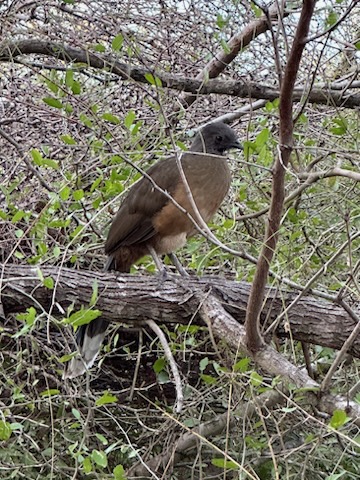

Viewing the Eclipse at El Sauz Ranch
By: Linda Wood
My favorite part of the State meeting was having lunch and viewing a solar eclipse with around 300+ of my favorite people (other Texas Master Naturalists) at El Sauz Ranch.


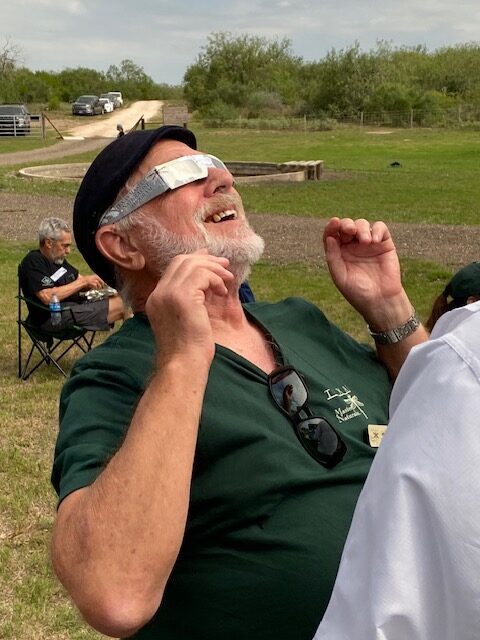
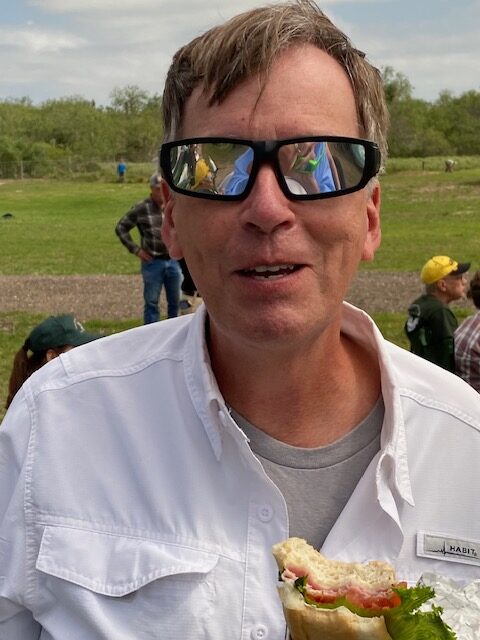

Experiences in The Rio Grande Valley
By: Layne Cassidy
I look forward to the Annual Meeting every year – this is my third to attend.
My highlights this year included:
- Learning all about monarchs at the National Wildlife Federation’s Monarch Citizen Science Workshop – how to test monarchs for OE – a protozoan parasite that infects monarchs and their migration and reproduction, and information about tagging and tracking monarchs throughout the US. This session was held at Quinta Mazatlan, and we saw a raptor migration overhead while looking for monarchs after the workshop.
- Thursday’s key note speaker on the history of the Rio Grande Valley (which is actually a delta and was named ‘valley’ for marketing purposes!) and how we only have 29 acres of dense sabal palm forest left out of an estimated 40,000 – 50,000 acres
- Attending a session from the Texas Wildlife Association on opportunities for private landowners to bring youth hunting on their lands, other opportunities for adults, free resources available for educators such as learning boxes, and programs for individuals about learning to hunt as an adult, birding, native plants, and more
- Birding at the Edinburg Scenic Wetlands and seeing dozens of bird species within just a couple of hours. Highlights included the Green Jay and the Chachalaca
- Watching the eclipse on El Sauz Ranch with 400+ of my fellow Master Naturalists!
- Visiting the El Sauz Ranch and hearing from biologists, education program managers, aquatic ecologists, farm business managers, and more about educational programs, grazing and grassland ecology, and educating children about land stewardship and jobs in conservation
- Learning all about Ocelots and the importance of private landowners working with programs to protect endangered species. We watched American Ocelot on the bus ride to the ranch, and it was unique to go to a place where so much of the footage was filmed. The Ocelot biologist told us they’ve caught Mama Jane (from the documentary) several times.
- Hearing from the TPWD Farm Bill Coordinator about technical and financial assistance for landowners to improve grasslands and contribute to the public good
- The silent auction – contributing to the Master Naturalist program and my stained glass collection!
- The vendors – learning about AgriLife Birding opportunities, bluebirds, bats, NASA educators, and more
- Celebrating the successes and milestones of our chapter members!
- And most importantly networking with fellow chapter members and spending time with friends from other chapters!
